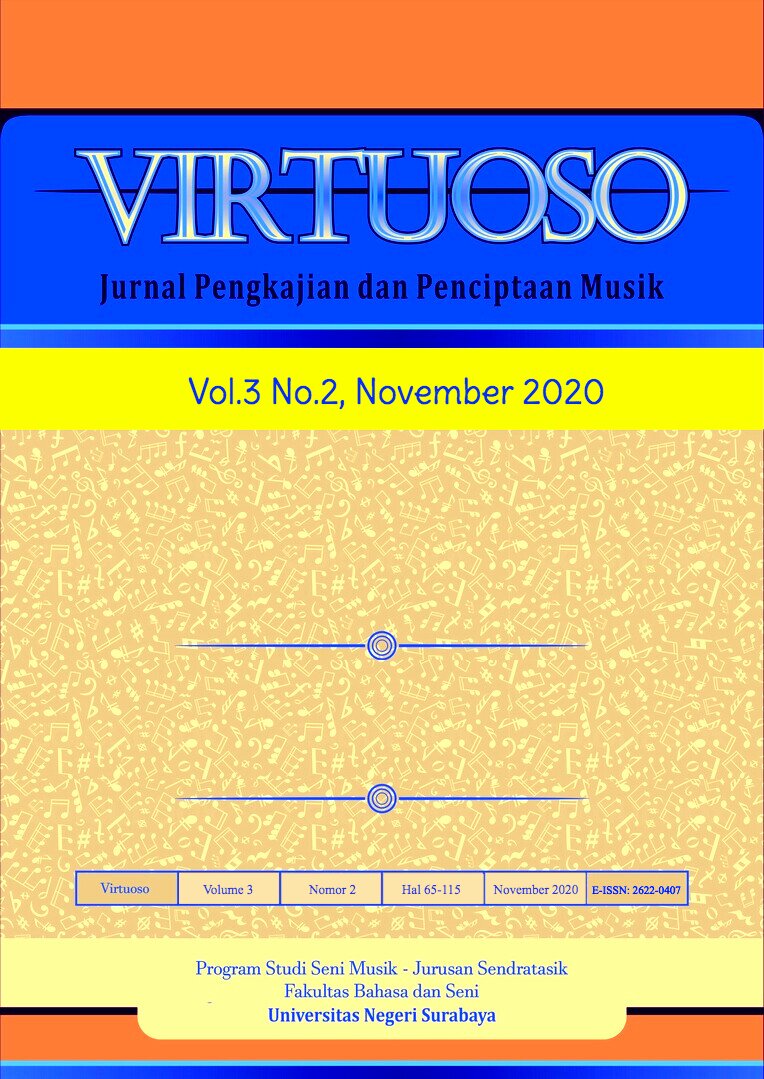Analisis Komposisi Soundtrack Epic œYou See Big Girl Karya Hiroyuki Sawano dalam Serial Animasi Attack on Titan
Main Article Content
Abstract
Action-fantasy are some movie genres that has the most expansive franchises in film industry and tend to use cinematic music to correlate the atmosphere and emotions of the movies imaginary universe. The analysis of You See Big Girlis due to its majestic cinematic music arrangement, its suitability in accompanying the battle scene, and also can be enjoyed as an independent track despite of its role in accompanying the scene. This qualitative descriptive research aims to analyze the musical composition technique by describing the epic musical element. This research contains of literature study, discography, and observation as the research methods, along with the approach of Lehman and Derrick Werlésexamine on epic music to analyze the epic element. The result shows that the You See Big Girl is one of the various epic music with the use of battle and war instrument, as well as tension built gradually from a section to the following by the use of polyrhythm, marcato accent, big crescendo, sequence, sudden silence to ends the musical phrase, ostinato, and abstract theme, to portray a majestic, vibrant, war and battle scene, and the greatness through the music.
Keywords: analysis, composition, animation, epic soundtrack, You See Big Girl
Downloads
Article Details
The copyright of the received article once accepted for publication shall be assigned to the journal as the publisher of the journal. The intended copyright includes the right to publish the article in various forms (including reprints). The journal maintains the publishing rights to the published articles.
References
Brownrigg, M. (2003). Film Music and Film Genre. Stirling: University of Stirling.
Buhler, J. (2017). Branding the Franchise: Music, Opening Credits, and the (Corporate) Myth of Origin. In S. C. Meyer (Ed.), Music in Epic Film: Listening to Spectacle (pp. 326). New York: Routledge.
Caturono, Y. (2019). Analisis Variasi Melodi dan Struktur Lagu pada Konserto Trumpet in Es Karya Joseph Haydn. Jurnal Pengkajian Dan Penciptaan Musik Virtuoso, 1 (2), 3440. https://doi.org/http://dx.doi.org/10.26740/vt.v2n1
Donelly, K. J. (2015). Magical Musical Tour: Rock and Pop in Film Soundtracks. New York: Bloomsbury Academic.
Husna, I. N. (2018). Analisis Teknik Permainan Biola pada Concerto in A Minor 3rd Movement RV 356 Op. 3 No. 6 Karya Antonio Vovaldi. Jurnal Pengkajian Dan Penciptaan Musik Virtuoso, 1 (2), 5056. https://doi.org/10.26740/vt.v1n2.p50-56
Jamalus. (1988). Panduan Pengajaran Buku Pengajaran Musik Melalui Pengalaman Musik. Jakarta: Proyek Pengembangan Lembaga Pendidikan.
Jarret, S., & Day, H. (2008). Music Compositions for Dummies. Indiana: Wiley Publishing, Inc.
Karl Edmund Prier. (2014). Sejarah Musik Jilid 1. Yogyakarta: Pusat Musik Liturgi.
Kusuma, S. R. (2019). Gaya Permainan Didiet Violin dalam Lagu œTurning Point. Jurnal Pengkajian Dan Penciptaan Musik Virtuoso, 2 (2), 106120. https://doi.org/10.26740/vt.v2n2.p106-120
Lehman, F. (2017). Manufacturing the Epic Score: Hans Zimmer and the Sound Significance. In S. C. Meyer (Ed.), Music in Epic Film: Listening to Spectacle (pp. 2755). New York: Routledge.
Moleong, L. J. (2004). Metodologi Penelitian Kualitatif. Bandung: PT Remaja Rosdakarya.
Persichetti, V. (1961). Harmony: Creative Aspects and Practice. New York: W.W. Norton & Company.
Phetorant, D. (2020). Peran Musik dalam Film Score. Journal of Music Science, Technology, and Industry, 3(1), 91102.
Prier, K. E. (1996). Ilmu Bentuk Musik. Yogyakarta: Pusat Musik Liturgi.
Putra, I. P. A. S. S. (2019). Analisis Komposisi Musik œKuasa Tanah. Journal of Music Science, Technology, and Industry, 2 (1), 4984. https://doi.org/doi: https://doi.org/10.31091/jomsti.v2i1
Rohmatullah, M. (2020). Musical Composition of Introverts and Ekstroverts Extramusical Idea. Journal of Music Science, Technology, and Industry., 3 (2), 125133. https://jurnal.isi-dps.ac.id/index.php/jomsti/issue/view/54.
Rosar, W. H. (2002). Film Music”Whats in a Name? The Journal of Film Music, 1 (1), 118. Retrieved from http://www.csulb.edu/~landerse/ifms/Editorial.pdf
Sitompul, A. (2017). Metamorfosis Kupu-Kupu: Sebuah Komposisi Musik. Jurnal Promusika, 5 (1), 1724. https://doi.org/https://doi.org/10.24821/promusika.v5i1
Stein, L. (1979). Structure and Style. The Study of Analysis of Musical Forms. Miami: Summy-Birchard Music.
Sterling, C. H. (2008). Military Communications: From Ancient Times to the 21st Century in Medieval Military Signaling (500-1500 CE). ABD-CLIO.
Stevenson, G. (1972). Discography: Scientific, Analytical, Historical, and Systematic. Urbana: University of Illnois.
Subana. (2011). Dasar-Dasar Penelitian Ilmiah. Bandung: Pustaka Setia.
Sugiyono. (2012). Metode Penelitian Kuantitatif Kualitatif dan R&D. Bandung: Alfabeta.
Tan, S.-L. (2016). The Psychology of Film Music: Framing Intuition. Music and the Moving Image, 9 (2), 2338. https://doi.org/https://doi.org/10.5406/musimoviimag.9.2.23
Turnbull, S. (2012). War in Japan 1467-1615. Oxford: Osprey Publishing.
Walus, B. P. (2012). A New Modular Approach to the Composition of Film Music. Adelaide: University of Adelaide.
Werlé, X. D. (2014). The Music of World of Warcraft: Lore of Epic Music [University of California]. Retrieved from https://escholarship.org/uc/item/2xk8k2mx

